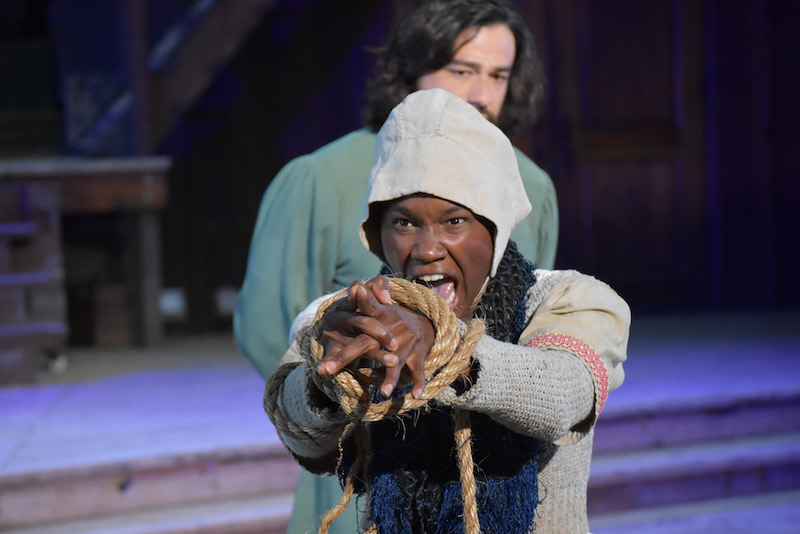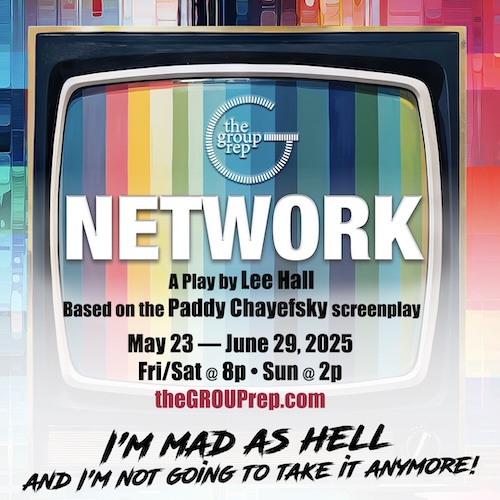Queen Margaret’s Version of Shakespeare’s War of the Roses
Reviewed by G. Bruce Smith
Will Geer Theatricum Botanicum
Through Oct. 1
Ellen Geer, artistic director of Will Geer Theatricum Botanicum, has undertaken an ambitious project by compiling and editing not one, but four, of Shakespeare’s history plays that she says puts the focus on the women characters. Specifically, she has taken scenes from Henry VI, Parts I, II and III, and Richard III, and stitched together a narrative that mostly succeeds in hitting the major beats of the violent tale of royal court intrigue in England in the 1400s.
Titled Queen Margaret’s Version of Shakespeare’s War of the Roses, this new edit follows 30 years of bitter infighting between the rival Lancaster and Plantagenet dynasties as they clash for power and the crown of England. War of the Roses is so thick with (real-life) characters, and battles, and plots, and murders that to follow this four-in-one play, an entire single-spaced, one-page synopsis is printed in the program. Suffice it to say that King Henry VI’s reign unravels over time until his murder by the notorious Richard III, who famously also murders his young nephews to gain the throne after the death of his brother, King Edward IV. All of this comes out of a tangled web of court intrigue, lusty ambitions, plots and counterplots, etc.
But Geer’s intent is to focus the story through the lens of the women of the play. Queen Margaret, Henry VI’s French wife, is clearly the prominent female in War of the Roses and the only one who is featured in all four of Shakespeare’s dramas. As such, she is the most developed – and interesting – of the women. We see her evolution from the coquettish young daughter of the titular king of Naples, to the fiercely ambitious queen who derides Henry’s weakness, to the fiery warrior, and finally the embittered and tragic old woman whose caustic tongue she uses to good effect. (Margaret made a relentless, but ultimately unsuccessful, effort to obtain the crown for her son, Prince Edward, who was murdered.) As Margaret, Melora Marshall is masterful at portraying her character’s progression, and Shakespeare gives her several hefty monologues that play to her talents. However, it stretched credibility for the mature Marshall to play the young Margaret – perhaps Geer, who also directed, could have cast a different actor in the younger role.
The other women – Duchess Eleanor, Lady Elizabeth Grey, the Duchess of York, Lady Anne, and Annette – are not as well developed and serve mostly to lament all the terrible things happening to and around them. (Though Willow Geer makes an interesting – and humorous – acting choice by portraying Duchess Eleanor’s ambition in an almost bimbo-like fashion.) And one other woman – Joan La Pucelle, better known as Joan of Arc, who appears at the beginning of the play – would best be cut from War of the Roses. She adds nothing of value to the narrative.
For the most part, it is possible to follow War of the Roses without being acquainted with the Bard’s four dramas. One exception is the appearance of Lady Anne, who is distraught at the murder of Henry VI. It’s confusing – was Lady Anne a mistress of Henry VI? No, as it turns out, she was his daughter-in-law, and Shakespeare establishes that Anne and the king were particularly fond of each other in a scene that does not appear in War of the Roses.
On the whole, the acting by an enormous ensemble (even with some major roles double cast) was excellent. Besides Marshall, standouts included Willow Geer as Duchess Eleanor and Lady Elizabeth Grey, and Jon Sprik as Duke of Suffolk and Richard III.
Visually, it’s always a delight to see a play in the stunningly beautiful, oak-studded outdoor amphitheater in rustic Topanga. And Geer uses every inch of the extensive and unique set, the foot paths that lead to backstage, the platforms, and the aisles in the audience to good effect. The lighting (Zachary Moore) enhances not only the action of the play, but the magic mood of the setting. Shon LeBlanc’s and A. Jeffrey Schoenberg’s costumes are spot on – Margaret’s various outfits are particularly effective as the character ages and changes over the years. Cavin (CR) Mohrhardt’s strong fight choreography, involving many actors, was a nice addition to the drama.
Henry VI has sometimes been seen as one of Shakespeare’s weakest works, particularly when contrasted with the more nuanced second historical tetralogy (Richard II, Henry IV, Part I and II, and Henry V). Which begs the question, why did Geer choose Henry VI/Richard III?
“It’s so like today. The intrigue of the court is just like what happens in Congress and the fight for the White House. It’s all about who deserves what and who did what to whom. All done for political rise and wealth,” says Geer in a press release. “Why do this play, you ask? Because watching as history repeats itself might someday bring folks to their senses.”
Perhaps. But Geer might be stretching the parallel a bit much. Regardless, if you’re willing to make the trek to a magical spot for a new perspective on these history plays, War of the Roses might just be for you.
Will Geer Theatricum Botanicum, 1419 N. Topanga Canyon Blvd., Topanga; in rep through Oct. 1. theatricum.com or call (310) 455-3723. Curtain is always at 7:30 pm. Running time 3 hours, including a 15-minute intermission.











